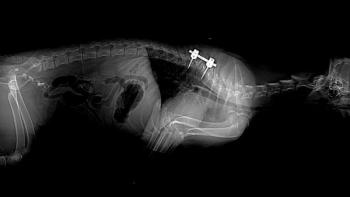
Will the seizures ever stop? Managing refractory epilepsy (Proceedings)
Seizure disorders, whether they are primary or secondary epilepsy, tend to be progressive because of the recruitment of neurons to seizure foci (also known as kindling). The decision on when to start treatment of seizures is always a compromise between the severity of the seizures, the progression of the seizures and the side effects of anti-epileptic drugs.
Seizure disorders, whether they are primary or secondary epilepsy, tend to be progressive because of the recruitment of neurons to seizure foci (also known as kindling). The decision on when to start treatment of seizures is always a compromise between the severity of the seizures, the progression of the seizures and the side effects of anti-epileptic drugs. The somewhat arbitrary recommendation to start treatment of seizures when they occur more than once a month is an attempt to intervene and control the seizures when they are occurring at a frequency that may cause kindling. This recommendation is not based on any scientific fact for our patients, and some authors recommend starting treatment at much lower seizure frequencies (e.g. one seizure every three months). In spite of current guidelines and the availability of effective anti-epileptic drugs, approximately 30% of epileptic dogs are not well controlled with monotherapy and become refractory epileptics.1 The most common manifestation of refractory epilepsy that we encounter at NCSU is cluster seizures. Cluster seizures are defined as more than one seizure occurring in a 24 hour period, and it is not unusual for a dog that clusters, to have more than 10 seizures within 48 - 72 hours.
Approach to refractory seizures
When faced with an animal that is having more than one seizure a month, whether they be in clusters or single events, there are several basic steps to take. The first is to re-evaluate the animal, especially if it has not been examined in the last 3 months, or if the change in seizure frequency is a new development. It is important to establish that there are no new neurological signs that might lead you to perform a repeat work up. Secondly, a minimum database including a bile acid tolerance test and measurement of blood levels of anti-epileptic drugs should be performed. The most critical information is the blood level of the drug. If the animal is on monotherapy, it is probably on phenobarbital, although it may be on potassium bromide. In either instance, the therapeutic options include increasing the drug dose or adding in another drug. Phenobarbital can be increased using the following equation: new dose = old dose X desired blood level / current blood level. It is preferable to keep blood levels of phenobarbital below 35μg/ml to lessen the risk of hepatotoxicity. Potassium bromide can be increased using the same equation and there is a very wide therapeutic range for this drug (100-300mg/dl). However, the blood level at which side effects are encountered varies widely between individual dogs and it is worth questioning the owner closely about whether they have seen any hind limb weakness or sedation prior to increasing potassium bromide.
Combination therapy
Phenobarbital and potassium bromide act at the same GABAa receptor and are synergistic. Addition of potassium bromide to dogs already on phenobarbital can therefore be very successful at controlling their seizures. For example, one study reported that 83% of dogs had better control of their seizures once potassium bromide was added to their phenobarbital regimen.1 Unfortunately however, both drugs cause polyphagia, PUPD and sedation with ataxia. For a small percentage of dogs, seizure control can be achieved with this combination of drugs, but at the expense of the dog's quality of life. Owners report that their pet is unable to exercise, falls frequently, and sleeps most of the time. In these cases, decreasing the dose of either phenobarbital or potassium bromide will improve the side effects, but unfortunately is often associated with renewed onset of seizures.
New anti-epileptic drugs
When seizure frequency is not adequately controlled by phenobarbital and potassium bromide, or unacceptable side effects occur, effective seizure treatment becomes problematic and expensive. Felbamate (Felbatol), gabapentin (Neurontin), levatiracetam (Keppra) or zonisamide (Zonegran) can be added to potassium bromide and phenobarbital. Unfortunately, all of these drugs are extremely expensive. The efficacy of these drugs has not been tested objectively as yet, and the relatively limited number of dogs treated so far means that we are still learning about all the side effects and beneficial effects of these drugs. However there are reports of the use of each of these drugs showing that they can be effective.
Felbamate is usually started at a dose rate of 15-20mg/kg p.o. q8 hours and the dose increased by 15mg/kg increments every 2 weeks until the seizures are controlled. Dose rates as high as 70mg/kg q8 hours have been used. It has been used successfully to treat focal seizures in dogs.2 The benefits of felbamate are that it does not cause sedation and its mechanism of action is different to phenobarbital and potassium bromide, thus it may be effective when these drugs have failed. Unfortunately it can cause hepatotoxicity and so is contra-indicated in dogs with hepatic disease, and liver function should be monitored routinely. Aplastic anemia has been reported in people and although not reported in dogs, a CBC should be monitored one month after starting therapy, and repeated every 3 months. Trough blood levels can be measured 1-2 weeks after starting therapy and should be in the range of 25-100mg/l. Because of its hepatotoxicity and the advent of newer drugs, this drug is rarely used.
Gabapentin is excreted largely via the kidneys and so is useful in dogs with hepatotoxicity. It has been used with success in dogs with cluster seizures.3 The dose rate is 25 – 60 mg/kg p.o. divided 3 to 4 times a day. Although this drug is reported to cause sedation, I have not found it to be any worse than the other drugs used and I have found it to be extremely effective in some cases.
Other drugs that are now commonly used include zonisamide4, levetiracetam5 and pregabalin6. There are reports of all drugs reducing the frequency of seizures in chronic epileptic dogs in uncontrolled trials. The recommended dose for zonisamide is 5 - 10 mg/kg twice a day with blood levels of 10-40 μg/ml. The higher dose is used when dogs are on concurrent Phenobarbital, due to increased rate of metabolism. Side effects reported include mild sedation and ataxia. I have seen it cause myoclonus in one case that resolved completely with withdrawal of the drug. Levetiracetam has few reported or anticipated side effects although it can cause sedation in dogs already on other antiepileptic drugs. Dose rates of 7 - 25 mg/kg q8 hours are suggested, but at NCSU we start at 20mg/kg three times a day. Pregabalin is dosed at 3 – 4mg/kg q8 hours, and has side effects of sedation and ataxia. Vagal nerve stimulation has proven effective in approximately 30% of people and dogs7, but is limited by the expense of the stimulators and the need for surgery.
Cluster seizure
Although dogs that have clusters of seizures may only experience them every 3 - 12 months, this can be a devastating problem because it typically ends with the dog being hospitalized. Over time, the emotional and financial stress on the owners can result in them electing for euthanasia. When faced with a dog that clusters, the basic steps in achieving seizure control (described above) should be undertaken. If clusters are still a problem, owners can be advised to give their dog one full additional dose of phenobarbital orally after a seizure once the dog can swallow to try to prevent a cluster from developing. This can be repeated up to once per hour, but if it has been repeated three times to no effect, the owner should seek veterinary help. Another strategy is for the owners to administer rectal diazepam (0.5mg/kg) after a seizure. There is a report that this is an effective approach to such cases7, however, owners must be instructed carefully in how to draw up and administer the diazepam. Finally, there are anecdotal reports of using an add on drug such as gabapentin around the time that a dog clusters. Many of these dogs seizure at very regular intervals and the owner is able to predict when the next group of seizures will occur and can administer additional gabapentin for that period.
Unfortunately, evaluation of the history of seizure treatment in people shows that, in spite of the advent of multiple new methods of treating seizures, the percentage of patients in whom seizure control is not reached has remained the same. We therefore await the identification of the chromosomal aberrations that underlie familial epilepsy with great anticipation.
References
Podell M, Fenner WR. Bromide therapy in refractory canine idiopathic epilepsy. J Vet Intern Med 1993;7:318-327.
Ruehlmann D, Podell M, March P. Treatment of partial seizures and seizure-like activity with felbamate in six dogs. J Small Anim Pract. 2001;42:403-8.
Platt SR, Adams V, Garois LS, Abramson CJ and Penderis J. Gabapentin as an adjunctive therapy for refractive idiopathic epilepsy in dogs. 16th Annual ESVN/ECVN Symposium, Prague, 2003.
Dewey CW, Guiliano R, Boothe DM, Berg JM, Kortz GD, Joseph RJ, Budsberg SC. Zonisamide therapy for refractory idiopathic epilepsy in dogs. J Am Anim Hosp Assoc. 2004;40:285-91.
Volk HA, Matiasek LA, Luján Feliu-Pascual A, Platt SR, Chandler KE. The efficacy and tolerability of levetiracetam in pharmacoresistant epileptic dogs. Vet J. 2008;176:310-9.
Dewey CW, Cerda-Gonzalez S, Levine JM, Badgley BL, Ducoté JM, Silver GM, Cooper JJ, Packer RA, Lavely JA. Pregabalin as an adjunct to phenobarbital, potassium bromide, or a combination of phenobarbital and potassium bromide for treatment of dogs with suspected idiopathic epilepsy. J Am Vet Med Assoc. 2009;235:1442-9.
Munana KR, Vitek SM, Tarver WB, Saito M, Skeen TM, Sharp NJ, Olby NJ, Haglund MM. Use of vagal nerve stimulation as a treatment for refractory epilepsy in dogs. J Am Vet Med Assoc. 2002;221:977-83. 7. Podell M. The use of diazepam per rectum at home for the acute management of cluster seizures in dogs. J Vet Intern Med. 1995;9:68-74.
Newsletter
From exam room tips to practice management insights, get trusted veterinary news delivered straight to your inbox—subscribe to dvm360.




